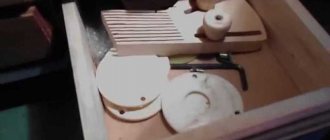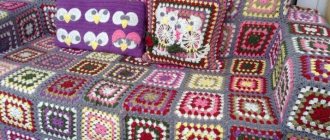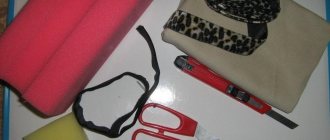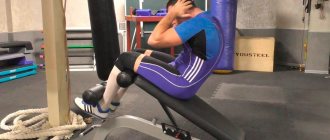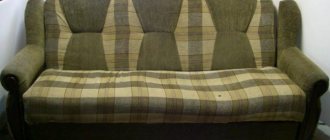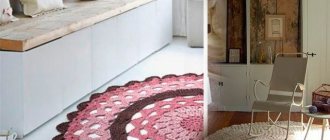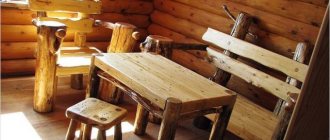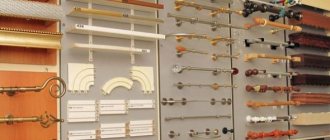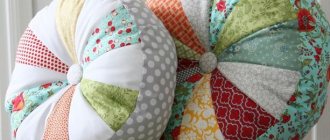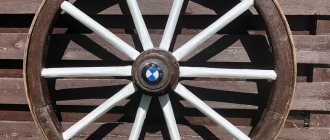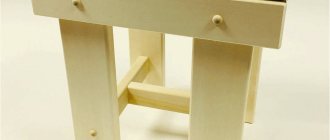Modern sofas are full of sophistication and are of amazing quality. They may not even have additional fittings that are necessary for human convenience. Designers exclude it from projects to make them original. An example would be armrests for a sofa. In this case, you need to think about how to make them yourself. They will also need to be done if there is an old piece of furniture in the house on which they have become unusable quite a long time ago.
The main material for the production of armrests is wood.
It’s worth talking in more detail about how to make armrests for a sofa with your own hands. There are many of them. First, you need to decide on a specific model in order to make armrests for the sofa that will fit perfectly into the interior.
Assembling the sofa armrest
Let's start with the usual parts - elbows.
Dimensions of the armrest: length – 900mm, width – 200mm, height – 550mm (600mm with legs). If you want to make an armrest with a shelf, then first take a look at this project. But please note that there are other dimensions and they need to be changed.
We assemble the armrest in accordance with the drawings. In the drawings, I did not label the dimensions of the parts so as not to clutter them up. Our list is small, it is difficult to confuse the details.
List of parts for the 1st(!) armrest. All dimensions are in millimeters.
- Chipboard : 160Х875 – 2 pieces
- 480Х875 – 1 piece
- 300Х775 – 1 piece
- 160Х510 – 2 pieces
- 875 – 2pcs
- 510Х880 – 1 piece
- 900Х200 – 1 piece
We take from the list the largest chipboard part and the two longest beams. The arrows in the drawing show the directions for tightening the screws. Please note that the screw rotates from the chipboard into the timber, and not the other way around. I recommend using 4X45 screws. You need to create a hole for the screw using a 3mm drill. If you use wood screws, then drilling will not be necessary. The step of attaching the chipboard to the beam (the distance between the screws) is at least 20 cm. Thus, screw four screws into each block in the upper figure in the direction of the arrow.
We screw two screws into the end of the beam. Since the screw is screwed into the end much easier, you only need to drill a hole for it to one-half the length, or with the narrowest drill.
The next step is to nail the fiberboard. We use 2X25 nails in increments of 10-15cm. If you are a fan of creating something that lasts forever, you can use wood glue in addition to nails. Don't forget to nail the fiberboard to the central beam (it is shown by the arrow).
To make it clearer for you, in this drawing I have labeled the sides of the elbowrest. We screw the chipboard overlay well, aligning it with the back and bottom edges. We use 35mm screws. Because We have a block running along the bottom edge; we screw it to it with longer screws.
The armrest is assembled, all that remains is to cover it with foam rubber. Everything here should be clear from the drawings. Before gluing the foam rubber, slightly smooth out the sharp corners and edges on the upper part of the armrest with a plane or a rough file. Please note that we do not glue foam rubber to the back wall of the armrest; you can simply glue a layer of batting there. I leave the choice of glue for foam rubber up to you. I myself use Tapicer glue, it is a professional glue and, as far as I understand, it is not sold in containers of less than 15 kg. If you can get hold of this kind of glue or its analogues somewhere, that’s great. Previously, almost everyone used glue88 for foam rubber. There are also special spray adhesives in cans. You can buy Titan glue at a hardware store; it is used for gluing ceiling tiles. I tested different adhesives for their ability to bond foam. You can read about it here: kley_dlja_porolona.html
For the sofa you need to make two similar (mirror) armrests. All! The elbows are ready for upholstery.
You can leave your reviews and questions in the Guest Book
Elbows for the sofa: making your own
Modern sofas are full of sophistication and classy quality. They may not even have additional fittings that are needed for human convenience. Designers exclude it from projects to make them unique. An example would be armrests for a sofa. In this case, you need to think about how to make them without the help of others. It will also be necessary to create them in this case, if the house has an old piece of furniture on which they have already fallen into disrepair for quite some time.
The main material for the production of elbows is wood.
It’s worth talking most carefully about how to make armrests for a sofa with your own hands. There are many of them. First, you should decide on a specific model in order to make armrests for the sofa that will perfectly fit into the interior.
Step-by-step instruction
The process of sewing covers for armrests consists of the following steps:
- Take measurements.
- Prepare the fabric - wash, dry and iron. This will avoid shrinkage of the finished product.
- Apply marks to the fabric taking into account the previously taken measurements. Don't forget about seam allowances.
- Cut out the details. There should be 4 of them. for each armrest - 2 side rectangles, 1 upper and 1 end. If the arms of the sofa are slightly rounded, which is often found in modern models, the last part can be made round, and the 2 side and top parts can be cut out in one piece.
- Sweep away all parts. This is very important even if the master believes that his measurements are as accurate as possible. It is not recommended to sew the product on a machine without basting and fitting. If you don’t want to use thread and a needle, you can carefully pin the product together with tailor’s pins along the future seam.
- Turn the cover right side out and place it on the armrest. If it fits well and you don’t need to change anything, then sew the parts together using a sewing machine.
- Remove excess threads and check seams for strength.
- Decorate the finished case with decorative elements, if necessary.
There is nothing difficult about sewing covers for sofa armrests yourself. The main thing is attentiveness and accuracy.
Source: postroika.biz
Choosing the type of elbow pads and material for them
The modern construction and furniture market provides a large number of different materials that allow even the most daring ideas to be realized. Obviously, traditional options are always in fashion. This can be said about elbows, which are made of wood. This particular material has long been considered the main one in furniture production. Sofa armrests are no exception. The tree may not necessarily be used in its own specific form. You can use derivatives from it.
Tools and materials
Tools for assembling sofa armrests: screwdriver, hammer, measuring tools.
Let’s look at how to make armrests for a sofa with your own hands from wood, so when choosing a material you definitely need to purchase the following:
- wood blocks;
- boards;
- varnish;
- screws and screwdriver;
- measuring tool.
All this can be purchased without any special problems at any hardware store. Now you can actually start working.
DIY armrests for a sofa: individuality
So, wooden elbows are made using a fairly standard technology. Obviously, work must begin with preparing the material for the upcoming manipulations with it. If there are old armrests, then they need to be dismantled. A screwdriver is also used for this. Screws can be removed using any method, but it must be gentle. The main thing is not to destroy the sofa system itself. This is the only way to perfectly install the latest elbow rests.
Scheme of the elbow with dimensions.
After dismantling is completed, you can begin measuring work. It is very important not to make mistakes in order to get truly high-quality furniture elements. You can use a ruler and pencil to measure. If the dimensions are impressive, then you can use a tape measure. To get the most accurate dimensions, you can use old elbows that were previously dismantled.
When all the preparatory work is completed, you can begin sawing the material. For these purposes, it is best to use an electronic jigsaw. But it cannot be used all the time, because the thickness of the boards is not the same everywhere. In some cases you will have to use the rest of your equipment. It could be a regular saw. Next, it is imperative to polish all the details. For this purpose, grinding machines of various classes are used.
You can also use a grinder on which a grinding wheel will be placed. You can use sandpaper for the final step.
Cutting the boards is done using jigsaws.
Now you can move on to the main step of the work - assembling the finished product. This can only be done after all the holes in the wood have been made in advance. To do this, take a drill with a drill of the appropriate diameter and drill it. This measure is necessary because preliminary making of holes will help to avoid unexpected destruction of the material during the assembly process.
By the way, you can proceed to them further.
All elements are connected into a single whole using screws.
It is important to use special plastic linings. They will perfectly hide all the imperfections of the material, as well as traces of work. They can be purchased at almost all furniture stores.
Assembly process
Varnish is applied to wooden surfaces in 2 layers.
Assembly is extremely fast. All pre-prepared holes are adjusted to each other, and then assembly takes place using self-tapping screws. The main thing is that all structural elements are firmly installed in place. This is the only opportunity to get a truly high-quality connection. After the assembly is completed, you can begin to coat the material with varnish.
Related article: Proper making of shelves with your own hands
The surface should be made as smooth as possible for this procedure. The varnish is applied in two layers. The first one must be pre-dried before the other one is laid on it. You can apply the varnish using a paint brush. If desired, the armrests can be additionally decorated with painting or wood carvings. This can bring the interior of almost any room to life as much as possible.
Everything should look as neat and natural as possible. If you can do this, then the job is done perfectly.
Summarizing
So, the work is done, which means we can sum up its results. The process of creating armrests for a sofa takes a limited amount of time. Everything can be done in a short time. Naturally, you can go to a furniture store and buy the latest sofa, but this requires a lot of money. You can simply remove the old elbow rests and install the newest ones in their space. This will significantly transform the interior of any room.
When working with wood, it is very important that the dry part is used. It does not have to have too much humidity, because this will cause it to swell and then dry out. The entire system may be damaged. The varnish can also be applied with a roller, but you should do it as carefully as possible, because the armrests are already installed on the sofa.
If they were not installed previously, you can even use a spray gun. By the way, it is not at all necessary to coat the surface with varnish. You can also use paint.
{Instructions}
1. First you need to decide on the width and height of the future elbow. Also take into account the width of the sofa armrest so that the shelf-armrest sits tightly and does not dangle. In my case it is 250 mm and 80 mm.
Dimensions of all parts in mm:
- 250x120x25 - counter on the sofa side
- 250x130x25 - table top
- 250x220x25 - long stand
- 250x120x25 - lower tabletop
- 250x100x25 - rack from the outside
Make the width of the upper and lower tabletops taking into account the width of bottles, mugs, and glasses.
2. File all the elements according to dimensions in pt 1.
3. Next, all elements must be fastened to dowels using transfer centers. If they are not there, you can simply use dowels with the color of one of the sides.
The accuracy of the alignment of parts during assembly will depend on the accuracy of the markings. Even if you make a mistake by a fraction of a mm, it will be noticeable.
4. We assemble the entire system on dowels without using glue for now. If all the elements fit perfectly, we glue them together; if not, we need to make new holes for dowels in problem areas.
5. Sand all the elements with an eccentric sander using paper with a grain size of 150-180. The smallest abrasive should not be used, because the oil will not adhere well to a perfectly polished surface.
6. Before gluing, all internal joints must be protected with masking tape or similar material to prevent the glue from being squeezed out onto the surface of the wood. Otherwise, you will have to re-grind in inaccessible places.
We glue all the elements together using clamps and leave the glue to set for 10-20 minutes. Remove the masking tape.
7. After 2-3 hours (but better the next day), remove the clamps, remove excess glue and sand the countertop and other open elements again. 8. Remove dust from the surface of the shelf and cover with oil. After 12-24 hours you can wax and polish.
Scheme of the design of the armrest stand
The dimensions may vary for each sofa, but in any case you will need the following boards:
- a) a board corresponding to the width of the sofa armrest;
- b) a board corresponding to the height of the armrest (inward);
- c) a board defining the size (height) of the additional compartment; For example, in this case the size was calculated for a laptop: the width of the laptop plus 5 cm.
- d) a board that determines the width of the compartment and is its lower part;
- e) a board that limits the separation on the second side.
{Instructions}
1. First you need to decide on the width and height of the future elbow. Also take into account the width of the sofa armrest so that the shelf-armrest sits tightly and does not dangle. In my case it is 250 mm and 80 mm.
Dimensions of all parts in mm:
- 250x120x25 - counter on the sofa side
- 250x130x25 - table top
- 250x220x25 - long stand
- 250x120x25 - lower tabletop
- 250x100x25 - rack from the outside
Make the width of the upper and lower tabletops taking into account the width of bottles, mugs, and glasses.
2. File all the elements according to dimensions in pt 1.
3. Next, all elements must be fastened to dowels using transfer centers. If they are not there, you can simply use dowels with the color of one of the sides.
The accuracy of the alignment of parts during assembly will depend on the accuracy of the markings. Even if you make a mistake by a fraction of a mm, it will be noticeable.
4. We assemble the entire system on dowels without using glue for now. If all the elements fit perfectly, we glue them together; if not, we need to make new holes for dowels in problem areas.
5. Sand all the elements with an eccentric sander using paper with a grain size of 150-180. The smallest abrasive should not be used, because the oil will not adhere well to a perfectly polished surface.
6. Before gluing, all internal joints must be protected with masking tape or similar material to prevent the glue from being squeezed out onto the surface of the wood. Otherwise, you will have to re-grind in inaccessible places.
We glue all the elements together using clamps and leave the glue to set for 10-20 minutes. Remove the masking tape.
7. After 2-3 hours (but better the next day), remove the clamps, remove excess glue and sand the countertop and other open elements again. 8. Remove dust from the surface of the shelf and cover with oil. After 12-24 hours you can wax and polish.
Step-by-step instruction:
Step 1: Connecting parts a + b
Using wood glue, we connect parts a and b together, following the diagram below. After the glue has dried, additionally secure the boards together with screws for a more durable fastening.
Note: Alternatively, if you want to leave the outside of the stand intact, secure the boards together from the inside with corner brackets and screws.
Step 2: Connecting parts c + d + e
Similar to the previous step, we connect parts c, d and e with glue, and then with screws, following the diagram given.
Step 3: Connecting all the parts together
Now you need to connect the parts assembled in the previous two steps. For this we also use glue and screws from the outside or corner brackets from the inside.
Note: You can also optionally add a board to cover the compartment at the front, that is, attach it to boards c, d and e.
Step 4: Apply putty
This step is necessary if you connected the parts together with screws from the outside and want to hide them. If you used corner brackets from the inside, then the outer surface is already smooth and does not require putty.
Here the screws were screwed in from the outside and the heads went slightly into the wood, forming small recesses. So we remove them using wood putty. After this, we smooth the surface with sandpaper so that the putty is level with the wood.
Step 5: Paint the stand
The color of the paint depends on your personal preferences; you can even varnish the wood, leaving its natural color and structure visible.
You can paint the entire stand, or just the outside, leaving the inside natural.
If you decide to paint the whole thing, apply the paint in several stages so that there is a side on which you can place a stand while the paint dries.
If you paint only the outside, then apply masking tape from the inside along the edges of the boards so that the paint does not get there and the inside looks neat. Here they just painted only the outer part.
TIP: In any case, when painting, you need to apply at least two coats of paint to ensure good coverage of the surface.
White paint, which is scratch-resistant, was used here.
Step 6: Attach the cork sheathing
Now all that remains is to attach the cork covering to the top of the stand. To do this, cut the cork fabric the width of the board located on top (board a), and the length a little more behind it so that you can wrap it under the board and attach it.
After this, apply spray adhesive to the surface of the top board and glue the cork fabric to it. Fold the edges inward and glue them; for reliability, you can secure them with decorative nails for furniture.
Now everything is ready!
- It took 3.5 hours to make a stand , and if you leave the natural color and do not apply paint, then the whole process takes about 1.5 hours.
- The result shows that the time was not wasted, because we get a beautiful and comfortable stand that increases home comfort!
We hope you enjoyed the master class, and soon you will be sitting relaxed on the sofa, drinking tea or coffee, and placing a cup on such a wonderful stand!
Source: kallibry.ru
Cost of materials and labor costs
The total cost of materials for making an oak shelf armrest with your own hands will average from 1000 to 1500 rubles.
- oak wood (furniture panel 20-25 mm wide) - 800 rub.
- grinding wheels, oil, wax, dowels and small items - 200 rubles.
It will take very little time to prepare, but you will enjoy using this shelf:
- marking and cutting - 30 minutes;
- marking for dowels, connecting to dowels - 90 minutes;
- polishing (2 times) - 30 minutes;
- fitting and {gluing} parts - 60 minutes;
- oil and wax coating - 30 minutes.
Thus, making an armrest for a sofa from solid wood with your own hands will take an average of 4 to 6 hours. Yes, this is not enough, you will have to spend almost the entire day off, but perfectly made furniture with your own hands is worth it

